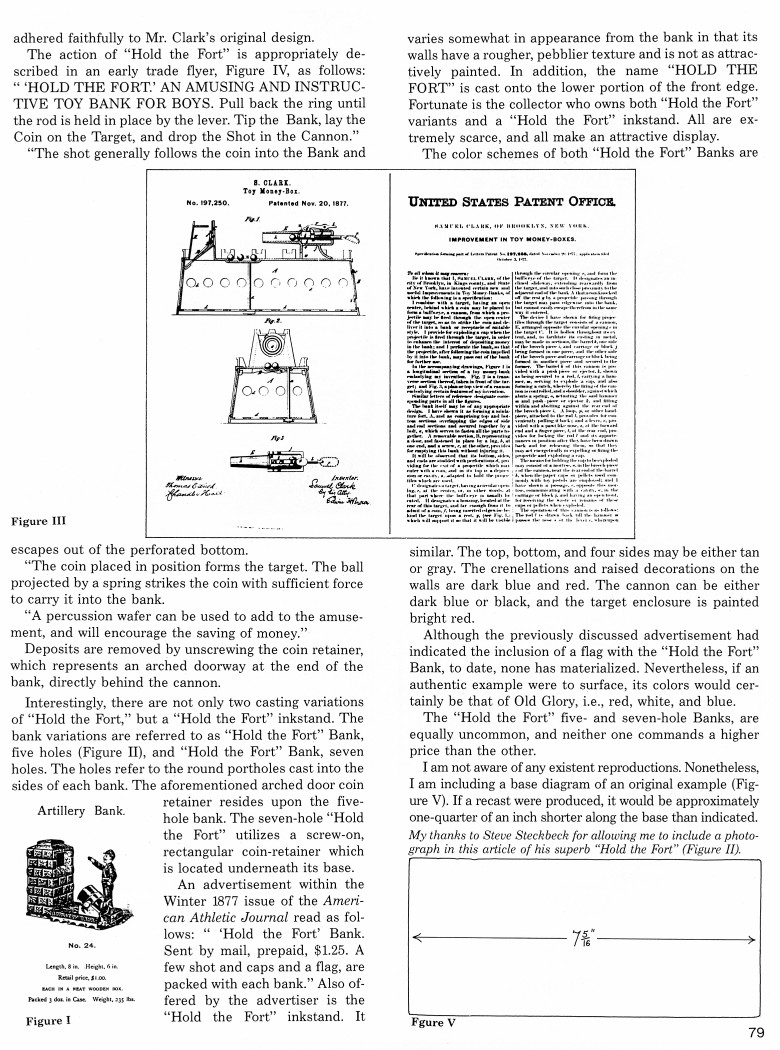|
Hold The Fort Bank
(Five Hole Variation)
by Sy Schreckinger – ANTIQUE TOY WORLD Magazine – February, 1993
War games and weaponry have always fascinated
youngsters. This becomes evident when children, and boys in particular,
are observed at play. They delight in brandishing cap pistols, arranging
toy soldiers in miniature army formations, and protecting their combatants
within the confines of the impenetrable fort.
Amongst those who recognized the opportunity to capitalize upon
these youthful militaristic fantasies were nineteenth-century mechanical
bank manufacturers. These entrepreneurs combined the theme of armed
conflict with the then-popular thrift-save-a-penny philosophy which was
sweeping the nation. Both the Shepard Hardware Company, of Buffalo, New
York, and the J. and E. Stevens Company, of Cromwell, Connecticut,
prominent bank manufacturers of the era, produced no fewer than five
variants of the "Artillery" Bank (Figure I). In addition, Stevens
manufactured the "Target" Bank and the "U.S. and Spain" Bank which also
incorporate the fort and the cannon theme.
Two other mechanical banks utilizing a fort and cannon are the "Fort
Sumpter" Bank and the subject of this month's article, "Hold the Fort"
Bank (Figure II). Unfortunately, there is little known information
pertaining to the manufacturers of either of these mechanicals. The "Hold
the Fort" Bank was designed and patented by Samuel Clark of Brooklyn, New
York. Mr. Clark was granted Patent number
197,250 on November 20, 1877
(Figure III). As indicated by the patent drawings, the manufacturer
adhered faithfully to Mr. Clark's original design.
The action of "Hold the Fort" is appropriately described in an early
trade flyer, Figure IV, as follows: "'HOLD THE FORT' AN AMUSING AND
INSTRUCTIVE TOY BANK FOR BOYS. Pull back the ring until the rod is held in
place by the lever. Tip the Bank, lay the Coin on the Target, and drop the
Shot in the Cannon." "The shot generally follows the coin into the Bank
and escapes out of the perforated bottom.
"The coin placed in position forms the target. The ball projected by
a spring strikes the coin with sufficient force to carry it into the bank.
"A percussion wafer can be used to add to the amusement, and will
encourage the saving of money." Deposits are removed by unscrewing the
coin retainer, which represents an arched doorway at the end of the bank,
directly behind the cannon.
Interestingly, there are not only two casting variations of "Hold the
Fort," but a "Hold the Fort" inkstand. The bank variations are referred to
as "Hold the Fort" Bank, five holes (Figure II), and "Hold the Fort" Bank,
seven holes. The holes refer to the round portholes cast into the sides of
each bank. The aforementioned arched door coin retainer resides upon the
five‑hole bank. The seven-hole "Hold the Fort" utilizes a screw-on,
rectangular coin-retainer which is located underneath its base.
An advertisement within the Winter 1877 issue of the American
Athletic Journal read as follows: " 'Hold the Fort' Bank. Sent by mail,
prepaid, $1.25. A few shot and caps and a flag, are packed with each
bank." Also offered by the advertiser is the "Hold the Fort" inkstand. It
varies somewhat in appearance from the bank in that its walls have a
rougher, pebblier texture and is not as attractively painted. In addition,
the name "HOLD THE FORT" is cast onto the lower portion of the front edge.
Fortunate is the collector who owns both "Hold the Fort" variants and a
"Hold the Fort" inkstand. All are extremely scarce, and all make an
attractive display.
The color schemes of both "Hold the Fort" Banks are similar. The top,
bottom, and four sides may be either tan or gray. The crenellations and
raised decorations on the walls are dark blue and red. The cannon can be
either dark blue or black, and the target enclosure is painted bright red.
Although the previously discussed advertisement had indicated the
inclusion of a flag with the "Hold the Fort" Bank, to date, none has
materialized. Nevertheless, if an authentic example were to surface, its
colors would certainly be that of Old Glory, i.e., red, white, and blue.
The "Hold the Fort" five and seven-hole Banks, are equally uncommon,
and neither one commands a higher price than the other.
I am not aware of any existent reproductions. Nonetheless, I am
including a base diagram of an original example (Figure V). If a recast
were produced, it would be approximately one-quarter of an inch shorter
along the base than indicated.
My thanks to Steve Steckbeck for allowing me to include a photograph
in this article of his superb "Hold the Fort" (Figure II).
|


